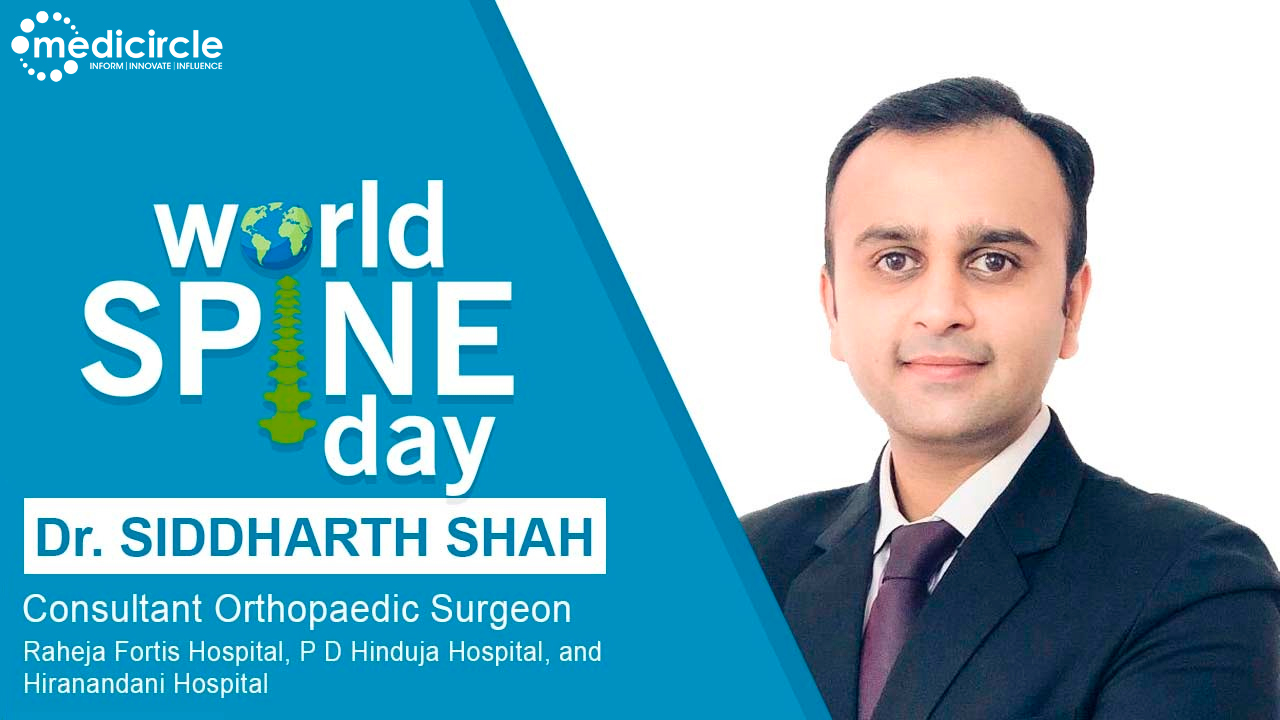The spine is our body's central support system. It connects different parts of your musculoskeletal system. Your spine helps you sit, stand, walk, twist and bend. Back pain and other spinal pains are now common in both old and young people. Back pain is a serious issue as it can make any person bed-ridden for days and even for years. Around 20% who suffer from back and neck pain are in the age group of 16-34. On average 45% of people in India neglect their spinal treatment for more than 7 weeks.
World Spine Day is celebrated on October 16 to inform people about the struggles faced by spinal pain and its disability. The day seeks to promote the overall health and wellbeing of one’s spine. The day is organized by the World Federation of Chiropractic. A good posture and staying active are important to ensure good spinal health. We at Medicircle are conducting the World Spine day Awareness Series wherein we will be featuring experts in this field to understand and create awareness about good spine health.
Dr. Siddharth M Shah is a Consultant Orthopedic Surgeon with a specialist experience of over 11 years, including 5 years of international experience (USA, UK, Australia, Singapore). He is affiliated with Raheja Fortis Hospital, Mahim, P D Hinduja Hospital, Khar, and Hiranandani Hospital, Powai.
He has published several pioneering research papers in the field of spine and joint replacements. Presently, he serves as Section Editor of the Indian Journal of Orthopedics and is on the Editorial Board of the American Journal of Arthroplasty. He has several awards and recognitions to his credit.
Dr. Siddharth says, "Almost 80% of the general population face back pain once in their lifetime. The vertebral column is also known as the spinal column or spine. It consists of a sequence of vertebrae (singular = vertebra), each of which is separated and united by an intervertebral disc. Together, the vertebrae and intervertebral discs form the vertebral column. It is a flexible column that supports the head, neck, and body and allows for their movements. It also protects the spinal cord, which passes down the back through openings in the vertebrae. The spinal cord functions primarily in the transmission of neural signals between the brain and the rest of the body.
Causes of back pain
Dr. Siddharth warns about the causes of back pain
Muscles strain – This can be because of lifting heavy objects or improper posture Sciatica – Sciatic nerve begins at your spinal cord, runs through your hips and buttocks, and then branches down each leg. When this nerve is irritated, you’ll experience sciatica. Spondylosis – Spondylosis is a general term for age-related wear and tear affecting the spinal disks. Fractures – Accidental fractures or patients with osteoporosis are prone to fractures. TB or bacterial infections – This also causes fever and loss of appetite. Cancer
Lifestyle modifications for a healthy spine
Dr. Siddharth mentions, “Our lifestyle habits have the vital role to play for back pain. Poor posture while standing or sitting, slouching while sitting, or looking at a phone puts extra stress on the spine over time. Some lifestyle modifications for a healthy spine
Adjust the height of your table so that your computer screen or laptop screen is at the same level of eyes. Feet rest flat on the floor or a footrest and your thighs are parallel to the floor.
To promote good posture when sitting, choose a chair that supports your lower back, your feet should touch the ground, and while sitting, hip joint and knee joints should be at 90 degrees.
Always work at your dedicated workspace.
If you work at a computer, make sure that your monitor, keyboard, mouse and chair are positioned properly. Avoid unnecessary bending, twisting and reaching.
If you sit for a prolonged period, change your position often. Take breaks in between, periodically walk around and gently stretch your muscles to relieve tension.
Quit smoking to reduce the risk of developing back pain.
Regular physical activity is also important like walking, swimming that strengthen and stretch your back muscles and abdomen.
Maintain your body weight.
Dr. Siddharth stresses, “To prevent or minimize back pain,
Pay attention to posture Avoid lifting heavy objects. While getting up from bed, get up on the sides to prevent strain on the back. Ice and heat compress for inflammation and relaxing muscle spasms. Topical application – gel or sprays While standing, balance your weight evenly on your feet. Don't slouch.
If your back pain lasts for more than a week, kindly consult a doctor.
Diet for a healthy spine
Dr. Siddharth illustrates, “Diet, exercise, and maintaining a healthy weight plays a major role-specific to back health.
Eating a balanced diet with the right amount and variety of vitamins and nutrients can reduce back problems and maintain ideal body weight. Take proper amounts of calcium and vitamin D in your diet. Calcium is found in many foods, most popularly in dairy products such as yogurt, cheese, and milk, green leafy vegetables. Sunlight is the natural source of vitamin D. Vitamin D is found naturally in only a few foods, including fatty fish (salmon), liver (or cod liver oil), and egg yolks. Too much calcium and vitamin D can also be harmful to the body. Anti-inflammatory food items should be consumed – beetroot, pomegranate, carrot, turmeric, ginger, garlic, fish, onion. Inflammation causing food items like processed foods, refined carbohydrates, sugars, oily foods should be avoided.
(Edited by Renu Gupta)

 Around 20% who suffer from back and neck pain are in the age group of 16-34. Back pain is a serious issue as it can make any person bed-ridden for days and even for years. Here are some valuable tips and advice right from the doctor for back pain.
Around 20% who suffer from back and neck pain are in the age group of 16-34. Back pain is a serious issue as it can make any person bed-ridden for days and even for years. Here are some valuable tips and advice right from the doctor for back pain.










.jpeg)

_(1)_(1)_(1).jpeg)
.jpeg)
.jpeg)
.jpeg)








.jpeg)
.jpeg)

.jpeg)


.jpeg)
